- Photo Safaris
- Alaska Bears & Puffins World's best Alaskan Coastal Brown Bear photo experience. Small group size, idyllic location, deluxe lodging, and Puffins!
- Participant Guestbook & Testimonials Candid Feedback from our participants over the years from our photo safaris, tours and workshops. We don't think there is any better way to evaluate a possible trip or workshop than to find out what others thought.
- Custom Photo Tours, Safaris and Personal Instruction Over the years we've found that many of our clients & friends want to participate in one of our trips but the dates we've scheduled just don't work for them or they'd like a customized trip for their family or friends.
- Myanmar (Burma) Photo Tour Myanmar (Burma) Photo Tour December 2017 -- with Angkor Wat option
- Reviews Go hands-on
- Camera Reviews Hands-on with our favorite cameras
- Lens reviews Lenses tested
- Photo Accessories Reviews Reviews of useful Photo and Camera Accessories of interest to our readers
- Useful Tools & Gadgets Handy tools and gadgets we've found useful or essential in our work and want to share with you.
- What's In My Camera Bag The gear David Cardinal shoots with in the field and recommends, including bags and tools, and why
- Articles About photography
- Getting Started Some photography basics
- Travel photography lesson 1: Learning your camera Top skills you should learn before heading off on a trip
- Choosing a Colorspace Picking the right colorspace is essential for a proper workflow. We walk you through your options.
- Understanding Dynamic Range Understanding Dynamic Range
- Landscape Photography Tips from Yosemite Landscape Photography, It's All About Contrast
- Introduction to Shooting Raw Introduction to Raw Files and Raw Conversion by Dave Ryan
- Using Curves by Mike Russell Using Curves
- Copyright Registration Made Easy Copyright Registration Made Easy
- Guide to Image Resizing A Photographers' Guide to Image Resizing
- CCD Cleaning by Moose Peterson CCD Cleaning by Moose Peterson
- Profiling Your Printer Profiling Your Printer
- White Balance by Moose Peterson White Balance -- Are You RGB Savvy by Moose Peterson
- Photo Tips and Techniques Quick tips and pro tricks and techniques to rapidly improve your photography
- News Photo industry and related news and reviews from around the Internet, including from dpreview and CNET
- Getting Started Some photography basics
- Resources On the web
- My Camera Bag--What I Shoot With and Why The photo gear, travel equipment, clothing, bags and accessories that I shoot with and use and why.
- Datacolor Experts Blog Color gurus, including our own David Cardinal
- Amazon Affiliate Purchases made through this link help support our site and cost you absolutely nothing. Give it a try!
- Forums User to user
- Think Tank Photo Bags Intelligently designed photo bags that I love & rely on!
- Rent Lenses & Cameras Borrowlenses does a great job of providing timely services at a great price.
- Travel Insurance With the high cost of trips and possibility of medical issues abroad trip insurance is a must for peace of mind for overseas trips in particular.
- Moose Peterson's Site There isn't much that Moose doesn't know about nature and wildlife photography. You can't learn from anyone better.
- Journeys Unforgettable Africa Journeys Unforgettable -- Awesome African safari organizers. Let them know we sent you!
- Agoda International discounted hotel booking through Agoda
- Cardinal Photo Products on Zazzle A fun selection of great gift products made from a few of our favorite images.
- David Tobie's Gallery Innovative & creative art from the guy who knows more about color than nearly anyone else
- Galleries Our favorite images
Giving Raptors a Future – Photography with Last Chance Forever
Giving Raptors a Future – Photography with Last Chance Forever
Submitted by David Cardinal on Thu, 05/06/2010 - 09:45
In addition to all the great songbird photography we had during our Texas Hill Country photo safari we had a special treat when John Karger of Last Chance Forever, a raptor rehabilitation foundation, brought four magnificent animals to pose and even fly for us. As my friend know I’m very careful about any photography of captive animals. It’s easy for them to be mis-treated or bred for photography once money is involved. But Last Chance Forever works strictly with raptors they are trying to rehabilitate after some accident or mis-treatment (usually unintentional) by a well-meaning “pet” owner...
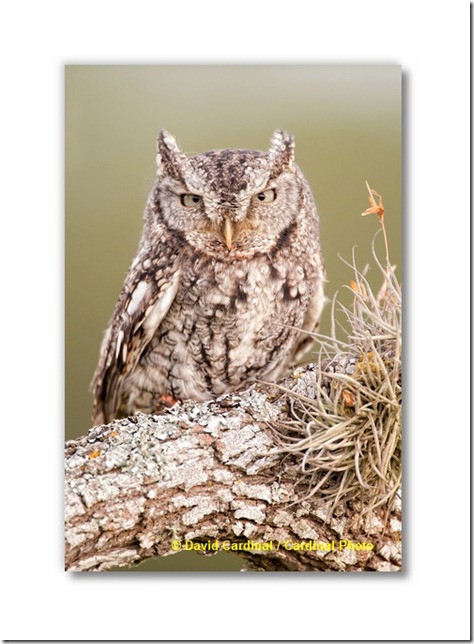
Eastern Screech Owl, Last Chance Forever Rehab Raptor
Nikon D700, 600mm f/4, 1/500s@f/4
Last Chance Forever
John has been doing this for over 30 years and I have certainly never met anyone with a deeper and more passionate knowledge of North American raptors. They are very well and very professionally cared for and he and his team follow just about every conceivable precaution to make sure they stay healthy and when physically possible can eventually be released to the wild. This trip John brought four great looking birds with him. An Eastern Screech Owl, A Harris’s Hawk, a Great Horned Owl and a Lanner Falcon (an exotic pet from Africa that John was asked to look after when it needed to be rehabilitated).
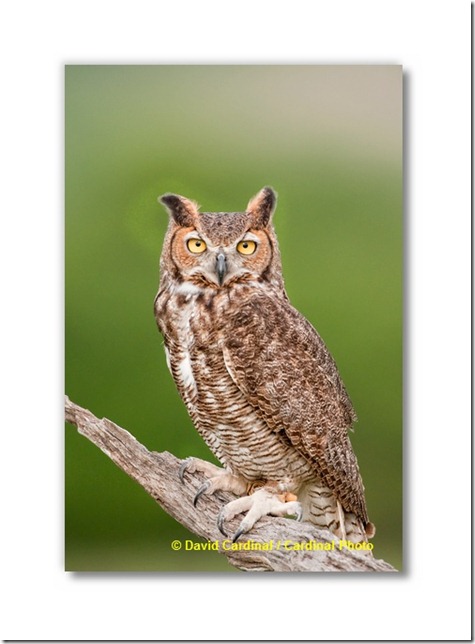
Great-horned Owl, Last Chance Forever Rehab Raptor
Nikon D700, 600mm f/4, 1/2000s@f/4
Backgrounds and Perches
We were fortunate that the Langfords and the Jays, our hosts for the week at the Block Creek Natural Area had photographed John and his raptors before, so they were way ahead of the curve when it came to finding attractive perches for the birds. The sky was more overcast than we might have wanted, giving us a bit of a cool light and of course no great blue sky backgrounds for flight shots. But the good news was the light never got harsh or hot and the birds had no problem comfortably perching and looking at us without worrying about the sun.
While we were of course not trying to hide the fact that these are captive birds, it is certainly much more attractive to pose them in ways where the required jesses are no more visible than necessary. So we went with largish branches for the perches where we could compose or crop the frame so that only the small portion of each jess on the bird’s foot was visible. Obviously even that could be cloned out fairly easily to make an “art print” of the birds. Larry had put a ball of moss on one branch to help disguise a broken limb and it turned out to add a lot of visual interest to the Screech Owl images.
One advantage of captive birds is that you can move around—as long as you are careful not to stress the bird—to find the background you want. I really liked the green trees as a traditional background but Larry encouraged us to also use the light gray sky as an alternative which did indeed make a nice “high-key” type image like the one below which I converted to black and white using nik SilverEfex Pro:
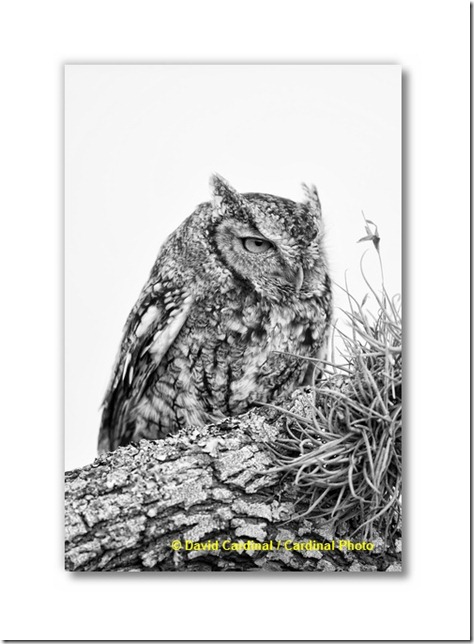
Eastern Screech Owl, Last Chance Forever Raptor
Nikon D700, 600mm f/4, 1/2000s@f/4
Converted to Black & White with nik SilverEfex Pro
Camera and Lenses
Of course captive birds also provide more flexibility in equipment. By changing your position you can photograph them successfully with any of a wide variety of bodies and lenses. I chose my D700 with vertical grip to get a combination of the excellent high ISO capability of the D700 (valuable to get flight shots on the cloudy day) and the high frame rate and convenient handling of the MB-D10 vertical grip. For the perching shots, I used my 600 f/4 since I had it with me, but a 200-400, 120-400 or even 70-300 would have been plenty of lens, especially on a smaller sensor. For flying speed is of course king, so the 70-200f/2.8 was ideal, although the new 70-300, 300f/2.8, 300f/4 or other mid-range quick AF lens would also have worked.
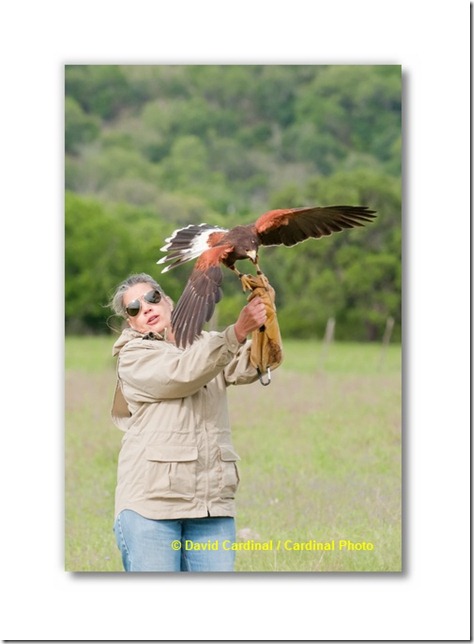
Sharron Jay of BCNA handling Harris’s Hawk
under John Karger of Last Chance Forever’s supervision
Flight Photography Opportunity
Even with captive raptors flight photography is hard work. With the gray sky we were forced to look for flight photographs against the much tougher to focus in front of grass and trees. It was a job for everyone’s fastest mid-range zoom. In my case that was a no-brainer as I’ll always rely on my 70-200 f/2.8 when I need speed to capture action. Fortunately we had great flexibility in how we positioned ourselves. By carefully arranging all of us on one side of the flight path we were able to have clean backgrounds as the birds flew from one handler to the other. As a special treat Sharron to to handle one of the birds as it was called to the other side of the meadow.
Knowing we’d have this opportunity we’d had a flight photography workshop session the evening before and some of the participants had already been practicing on the numerous Purple Martins in the area. The practice paid off as everyone got at least some sharp images.
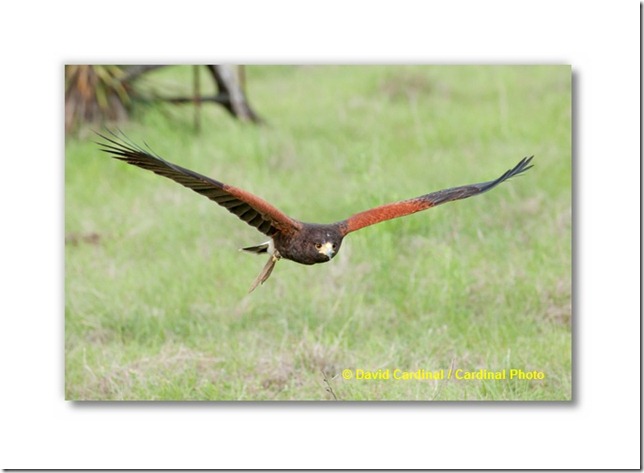
Harris’s Hawk (originally known as Bay-winged Hawk) flying “free” from Sharron to Ian
Last Chance Forever Rehab Raptor, Nikon D700, 70-200mm f/2.8, 1/2000s@f/5, ISO 800
Captioning Captive Bird Photographs
The first thing I do after a captive shoot is add a keyword of either “Captive” or “Non-wild” to all my images. In many of them it is clear the birds are captive because they are being handled or their flying jesses are visible. But in some they aren’t and I certainly never want to make a mistake and confuse an image of a captive bird (I think of these animals as captive or non-wild even when they are flying as they are trained to behave and return).
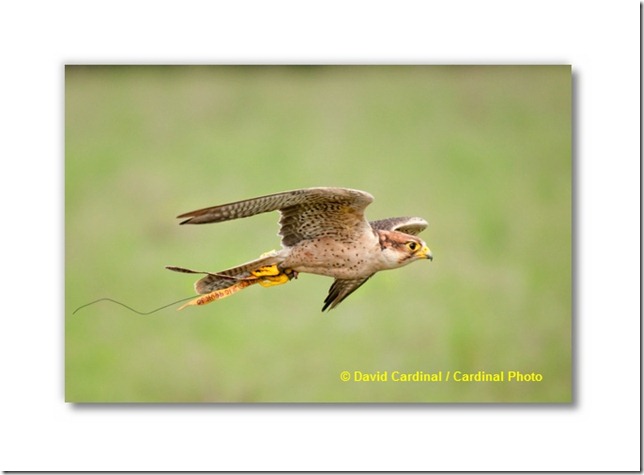
Endangered Lanner Falcon with transmitter, Last Chance Forever Raptor
Nikon D700, 70-200mm f/2.8, 1/3000s@f/4, ISO 800
A Real Treat Worth Repeating
We all had a great time and learned an incredible amount from John about the birds and their care (and sadly their stories of mis-treatment that led them to John’s care). We are definitely going to make Last Chance Forever a regular part of our Texas Hill Country photo safaris. If you’d like to learn more about our April 2011 trip email us at safaris [at] cardinalphoto.com or see the webpage on this year’s trip.
- Log in to post comments

